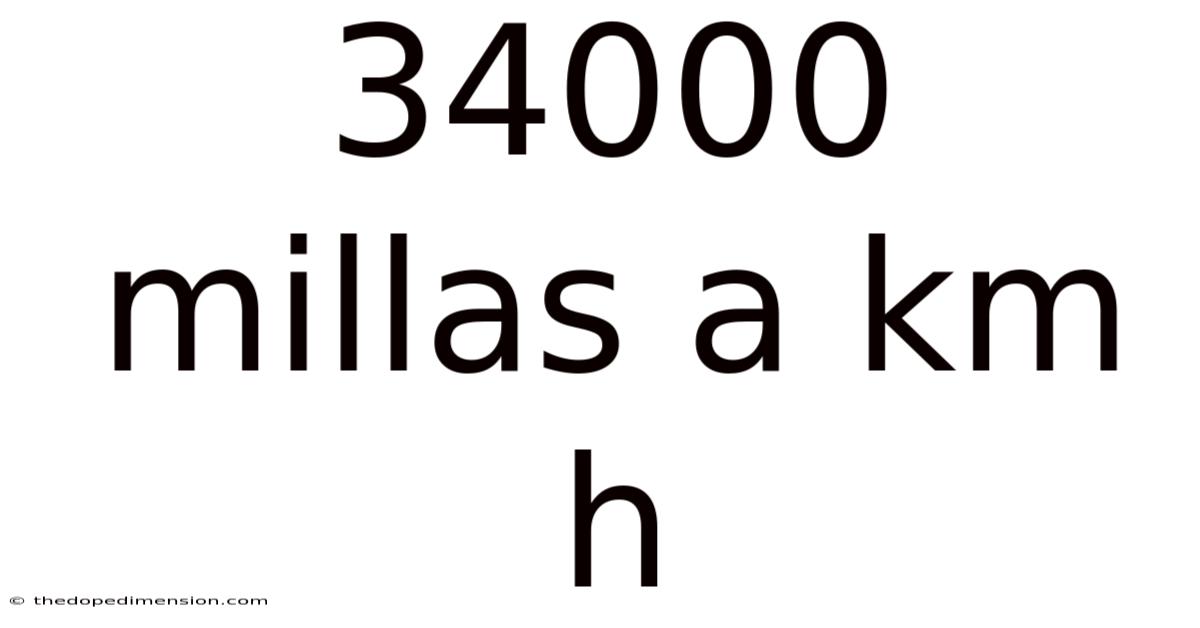34000 Millas A Km H
thedopedimension
Sep 20, 2025 · 4 min read

Table of Contents
Converting 34,000 Miles to Kilometers per Hour: A Comprehensive Guide
Are you curious about how fast 34,000 miles is in kilometers per hour? This seemingly simple conversion problem actually touches on several important concepts in unit conversion and speed calculation. This article will not only provide you with the answer but also delve into the underlying principles, helping you understand the process and apply it to other similar conversions. We'll cover the conversion itself, explore the practical implications of such a high speed, and address frequently asked questions.
Understanding the Conversion Process: Miles to Kilometers
The core of this problem lies in converting miles to kilometers. These are both units of distance, but they belong to different systems: miles to the imperial system and kilometers to the metric system. The conversion factor is crucial here. One mile is approximately equal to 1.60934 kilometers. This is a constant value you'll need to remember or readily access whenever you perform such conversions.
Calculating the Distance in Kilometers
To convert 34,000 miles to kilometers, we simply multiply the number of miles by the conversion factor:
34,000 miles * 1.60934 kilometers/mile ≈ 54,717.56 kilometers
Therefore, 34,000 miles is approximately equal to 54,717.56 kilometers.
The Importance of Specifying "per Hour"
The question asks for the speed in kilometers per hour. The conversion above only deals with the distance. The "per hour" part indicates a speed or velocity, which is distance traveled per unit of time (in this case, an hour). To express 34,000 miles as a speed in kilometers per hour, we need additional information: the time taken to travel that distance. Without knowing the time, we cannot calculate the speed.
Hypothetical Scenarios and Speed Calculations
Let's explore a few hypothetical scenarios to illustrate how to calculate the speed in kilometers per hour:
Scenario 1: Traveling 34,000 miles in 10 hours
If it takes 10 hours to travel 34,000 miles, the speed is:
34,000 miles / 10 hours = 3,400 miles per hour
Now we convert this speed to kilometers per hour:
3,400 miles/hour * 1.60934 kilometers/mile ≈ 5,471.76 kilometers per hour
Scenario 2: Traveling 34,000 miles in 24 hours
If the journey takes 24 hours, the speed becomes:
34,000 miles / 24 hours ≈ 1,416.67 miles per hour
Converting to kilometers per hour:
1,416.67 miles/hour * 1.60934 kilometers/mile ≈ 2,279.3 kilometers per hour
Scenario 3: A more realistic scenario – a spacecraft
Let's consider a spacecraft traveling at a high speed. Imagine a spacecraft covers 34,000 miles in just 1 hour. This is a highly unrealistic speed for current technology, but it illustrates the calculation:
34,000 miles / 1 hour = 34,000 miles per hour
Converting to kilometers per hour:
34,000 miles/hour * 1.60934 kilometers/mile ≈ 54,717.56 kilometers per hour
Practical Implications of High Speeds
The speeds calculated above, especially in scenarios 1 and 3, are incredibly high. To put them into perspective:
- Scenario 1 (5,471.76 km/h): This speed is significantly faster than the speed of sound (approximately 1,235 km/h). Only highly advanced aircraft and spacecraft could achieve such speeds.
- Scenario 3 (54,717.56 km/h): This speed is significantly faster than the speed of sound and even faster than many spacecraft currently in operation. Such speeds are typically associated with interplanetary travel.
The Significance of Units and Precision
Pay close attention to the units involved. Always clearly state the units of distance and time. Also note that our conversions involved rounding. For extremely precise calculations, you should use the full value of the conversion factor (1.609344 kilometers per mile) and avoid rounding until the final step.
Frequently Asked Questions (FAQ)
Q1: What is the exact conversion factor from miles to kilometers?
A1: The exact conversion factor is 1.609344 kilometers per mile. However, for most practical purposes, 1.60934 is sufficiently accurate.
Q2: Can I use online converters for this type of conversion?
A2: Yes, many online unit converters are available to perform this conversion quickly and easily. However, it's beneficial to understand the underlying principles to avoid errors and to solve similar problems independently.
Q3: What are some real-world applications of this type of conversion?
A3: This type of conversion is essential in various fields, including:
- Aviation: Converting flight distances and speeds.
- Space exploration: Calculating distances and velocities of spacecraft.
- Transportation: Converting distances for logistics and route planning.
- Geography: Converting map distances and scales.
- Scientific research: Converting measurements in different unit systems.
Q4: Why is it important to understand unit conversions?
A4: Unit conversions are fundamental to many scientific and engineering calculations. A lack of understanding can lead to significant errors and misinterpretations. It is a crucial skill to develop for success in many STEM-related fields.
Conclusion
Converting 34,000 miles to kilometers requires understanding the conversion factor between miles and kilometers. Expressing this distance as a speed necessitates knowing the time taken to travel that distance. We explored several hypothetical scenarios to illustrate the calculations. The resulting speeds highlight the importance of understanding units and precision in calculations. The concepts discussed here are applicable in various real-world scenarios, emphasizing the importance of mastering unit conversions in various fields. Remember always to pay close attention to units and use the appropriate conversion factors for accurate results.
Latest Posts
Latest Posts
-
How Much Is 28 Inches
Sep 20, 2025
-
What Does Centi Prefix Mean
Sep 20, 2025
-
450 Canadian To Us Dollars
Sep 20, 2025
-
What Is 23 In Cm
Sep 20, 2025
-
How Much Is 750 Milligrams
Sep 20, 2025
Related Post
Thank you for visiting our website which covers about 34000 Millas A Km H . We hope the information provided has been useful to you. Feel free to contact us if you have any questions or need further assistance. See you next time and don't miss to bookmark.